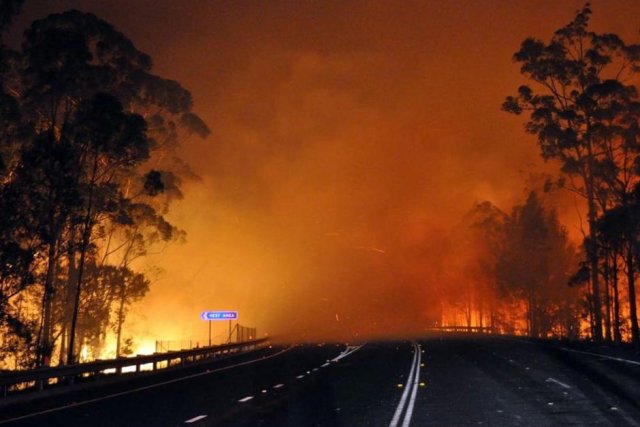
A “dome of heat” has settled over Australia, causing a heatwave in every state and territory and widespread bushfires. Tasmania has been the worst hit with 150 homes damaged or destroyed.
“The current heatwave — in terms of its duration, its intensity and its extent — is unprecedented in our records,” David Jones from the Bureau of Meteorology (BOM) told the Sydney Morning Herald on January 9. Clearly, the climate system is responding to the background warming trend. Everything that happens in the climate system now is taking place on a planet which is a degree hotter than it used to be.''
Temperature records that have stood for almost a century are being shattered. The BOM said “the first 8 days of 2013 have been in the top 20 hottest days on record, with January 8 the third hottest on record and the first time 7 consecutive days over 39°C has ever been recorded for Australia.”
ABC news said on January 8 “Alice Springs has had six straight days above 42°C and Yulara near Uluru has had five above 44°C - records for both towns.”
In the South Australian town of Oodnadatta, it was so hot that petrol evaporated at the pump, making it impossible for people to refill their cars.
This is the same town where Australia’s highest-ever temperature of 50.7°C was recorded in 1960. The BOM not only anticipated this record could be broken but was forced to add new colours to its forecast map to display the predicted temperatures of an unprecedented 50-54°C.
This prolonged heatwave can be expected to cause deaths. Liz Hanna, convener of the Climate Change Adaptation Research Network at the Australian National University said, “heat alone already kills more Australians than the road toll. If it is not already double, it soon will be.”
“The most vulnerable to heat include the elderly, those with heart conditions and the very young.”
A report on the 2009 Victorian heatwave found it may have contributed to the deaths of 374 people. Already this summer, two people have died in separate incidents while bushwalking in 40°C heat.
The heatwave has also created conditions for bushfires that are more intense than ever before. After the 2009 Black Saturday fires in Victoria that killed 174 people, a new category of fire danger was created to warn the public that under new extreme conditions the normal methods of coping with fires was no longer possible.
The new category — catastrophic — officially advises people to evacuate the area if a fire starts; under no circumstances should anyone stay to defend their homes, even if they are well prepared and houses are well constructed. Authorities warn that “fires are likely to be unpredictable and very fast moving with highly aggressive flames extending high above tree tops and buildings.”
NSW experienced its worst fire danger day in recorded history on January 8. Three regions were classed catastrophic. The rest of the state was classed under “extreme danger”.
This is the new normal we can expect from the changing climate. Prime Minister Julia Gillard said during a visit to Tasmania that: “We do know that over time as a result of climate change we are going to see more extreme weather events.”
Climate change is playing havoc with regional weather patterns as well. Part of the reason the heatwave is lingering is because the northern monsoon that arrives from Asia at this time of year has been delayed.
Despite this, the Australian government is taking no meaningful action to stop climate change from getting worse. Australia is the largest exporter of coal in the world, an amount that is set to double in the next decade. Instead of transitioning to renewable energy, the government is encouraging investment in coal and gas. Nine new mega-coalmines have been proposed for Queensland that, if approved, will triple Australia’s carbon emissions.
Public service cuts by the NSW Liberal government are making the situation worse. Emergency services that fight fires and respond to the aftermath are being forced to cut staff or close stations due to agencies being forced to slash budgets.
The Fire Brigade Employees Union said: “The government’s response is to cut funding and, by extension, existing jobs, thereby placing even more strain on the system. The government’s approach is making a bad situation worse.”